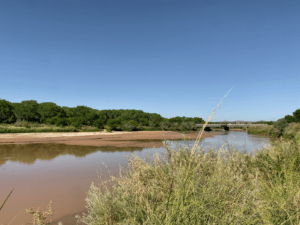By Aidan Manning, Rivers and Waters Program Associate
On September 11th of this year, the Middle Rio Grande Conservation District (MRGCD) warned that sections of the Rio Grande in Albuquerque may run dry for the third year in a row. Now, a month later, early winter season storms are starting to light up the precipitation forecasts, and it appears that we have narrowly avoided the desperate conditions as were seen last year and the one before, when the River dried up in Albuquerque for the first time in four decades. But it can be difficult to celebrate the weak, trickling flows that remain in parts of the riverbed when odds are good that the same problem emerges next year and the year after. In fact, until major infrastructure updates are completed, we can expect partial or complete drying of this reach to be a new normal for the Rio Grande.
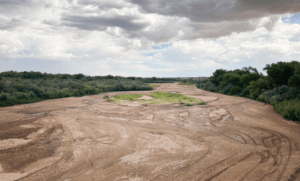
The Middle Rio Grande’s dependence on seasonal flows and storage makes it particularly sensitive to drying. Every year, spring snowmelt in the high mountains of Colorado and Northern New Mexico generates the majority of the Rio Grande’s annual flow. These snowmelt-driven flows, which peak in late spring or early summer, contribute to the Rio Grande watershed like a paycheck being deposited in a bank account, which are then stored by humans and nature and slowly released throughout the summer and fall growing season.
Rio Grande is seeing more dry miles in recent years because its storage capacity has shrunk immensely relative to water use. Warming temperatures are driving higher evaporation rates throughout the watershed, meaning ecosystems and human uses like municipal supply and agriculture need more water to function. On the other hand, the components of our watersheds that store water have become less and less functional over time, meaning we enter every growing season with insufficient savings to tide us over until the winter. Thus, we end up praying for summer rains, which are only becoming less reliable, to help keep water users afloat until winter, and .
The crippling of El Vado Dam, which has been out of commission for repairs since 2022, is the most obvious blow to the water storage capacity for the Middle Rio Grande. El Vado is the only major reservoir upstream of Albuquerque that is managed to store native Rio Grande Basin water. Other large dams in central and northern New Mexico are generally only permitted to manage floods and sediment or store water imported across the Continental Divide from the San Juan River Basin. Administrative adjustments, some of which have been put in place this summer, can help other reservoirs pick up some of El Vado’s slack, but until this key reservoir is functional again (which will take years), water managers will remain severely hampered in their ability to store bountiful spring flows for late season use.
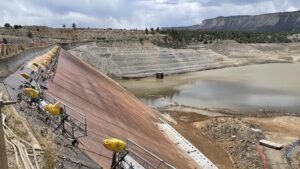
However, the degradation of water storage capacity in the Rio Grande Basin extends beyond aging human-made infrastructure. The River’s natural water storage systems, such as alpine snowpacks and riparian ecosystems, have been undergoing systematic destruction for centuries. We often forget that snow itself is not the source of water so much as the first and by far the largest water storage infrastructure in the Upper and Middle Rio Grande Basins. Snowpacks store winter precipitation until spring and early summer, even lasting until July in many high alpine basins. Climate change is causing snowpacks in the Upper Rio Grande to shrink and melt out about three weeks earlier than half a century ago, and the result is an earlier end to stored water supplies each summer or autumn.
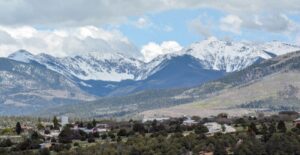
In a healthy Rio Grande Basin, floodplains and wetlands would add to natural water storage capacity throughout the basin. These stream- and river-adjacent ecosystems evolved with regular seasonal flooding, allowing water to soak into floodplain soils and recharge shallow aquifers that fed back into the river during dry conditions. Beavers and their dams also help build natural water storage by creating wetlands and raising the groundwater table. Unfortunately, these water-buffering ecosystems have been literally decimated over the last two centuries. In the mid-twentieth century, most of New Mexico’s perennial rivers were channelized and bound by levees. These efforts created new dry lands for building and agriculture, but they prevented floodwaters from recharging soils and aquifers each spring. Meanwhile, beavers were hunted and trapped for their valuable pelts, and without their tending, thousands of miles of perennial streams have degraded from water-storing wetlands to rapidly draining incised channels.
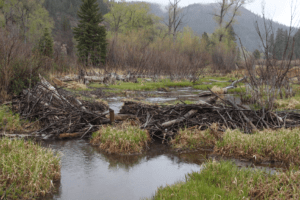
The dominant forces in New Mexico’s water resource management have spent the past century taking natural water storage systems for granted. In an effort to “reclaim” water, we’ve constructed dams, straightened channels, and lined ditches in cement. These activities increased efficiency and reliability for human water uses, but they damaged vast water-storing ecosystems and made our water supply more dependent on a few large reservoirs like El Vado. Now, as aridification forces New Mexico to reassess how we use our most precious resource, a broad community of researchers, stewards, managers, and knowledge-keepers are gathering to find new ways to balance the efficiency of human-built water infrastructure with the flexible buffering capacity of natural ecosystems. Efforts like reintroducing beaver and improving environmental flows in rivers show great promise for restoring riparian areas. But these efforts are based in a systems-oriented perspective that goes against the grain of 20th century water management practices. Their implementation and success will depend on consistent effort from people around the state who understand that a river is not merely a big ditch connecting reservoirs and diversion dams, but a vast and complex living system containing its own value and functions outside human water use.
